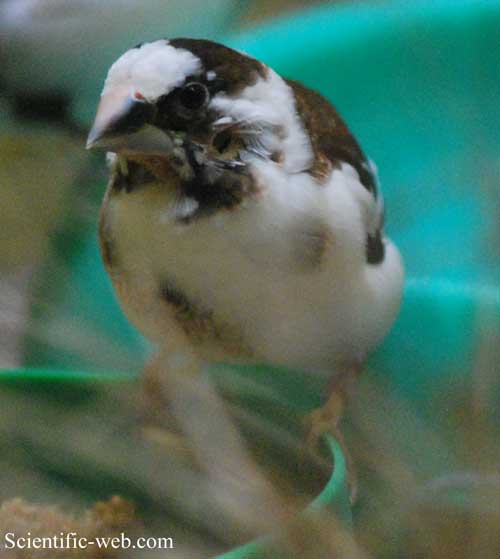Cladus: Eukaryota
Supergroup: Opisthokonta
Regnum: Animalia
Subregnum: Eumetazoa
Cladus: Bilateria
Cladus: Nephrozoa
Cladus: Deuterostomia
Phylum: Chordata
Subphylum: Vertebrata
Infraphylum: Gnathostomata
Superclassis: Tetrapoda
Classis: Aves
Subclassis: Carinatae
Infraclassis: Neornithes
Parvclassis: Neognathae
Ordo: Passeriformes
Subordo: Passeri
Parvordo: Passerida
Superfamilia: Passeroidea
Familia: Estrildidae
Genus: Lonchura
Species: Lonchura striata
Subspecies: L. s. acuticauda - L. s. explita - L. s. fumigata - L. s. semistriata - L. s. striata - L. s. subsquamicollis - L. s. swinhoei
Name
Lonchura striata (Linnaeus, 1766)
References
* Syst. Nat. ed.12 p.306
Vernacular names
Basa Sunda: Piit
Deutsch: Spitzschwanz-Bronzemännchen
English: White-rumped Munia
Nederlands: Spitsstaartbronzemannetje
Português: Manon-de-peito-branco
Русский: Острохвостая бронзовая амадина
中文: 白腰文鳥
The White-rumped Munia or White-rumped Mannikin (Lonchura striata), sometimes called Striated Finch in aviculture, is a small passerine bird from the family of waxbill "finches" (Estrildidae). These are close relatives of the true finches (Fringillidae) and true sparrows (Passeridae).
It is native to tropical continental Asia and some adjacent islands, and has been naturalized in spome parts of Japan. Its domesticated hybrid descendant, the Society Finch or Bengalese Finch, is found worldwide as a pet and a biological model organism.
Description
Adult L. s. acuticauda preening after bathing, Narendrapur near Kolkata (West Bengal, India)
The White-rumped Munia is approximately 10 to 11 cm in length, with a stubby grey bill and a long black pointed tail. The adults are brown above and on the breast, and lighter below; the rump is white. There is some variation between the subspecies, but the sexes are almost impossible to distinguish in all subspecies; males have a more bulky head and bill.[1]
Subspecies include:[2]
* Lonchura striata acuticauda – Northwestern White-rumped Munia. Northern Indian mainland below c.1,500 meters ASL, north through the Himalayas foothills of Bhutan and Nepal to the Dehradun region of Uttarakhand (India).
Medium brown above, except on the face and remiges, buffy below.
* Lonchura (striata) domestica – Society Finch. Domesticated; naturalized in Japan.
A number of breeds have been developed, ranging from white through yellowish, grey, rufous and brown to almost black, with more or less lighter belly; piebald birds are common, and more fanciful breeds with crests or curled feathers are also available.
* Lonchura striata semistriata (Hume 1874) – Nicobar White-rumped Munia. Car Nicobar and Central (Nancowry) group, Nicobar Islands
* Lonchura striata squamicollis – Chinese White-rumped Munia. Southwestern China and adjacent regions.
* Lonchura striata striata (Linnaeus, 1766) – Southwestern White-rumped Munia. Southern Indian mainland
Dark chocolate-brown above, white below.
Ecology
The White-rumped Munia is a common resident breeder ranging from South Asia to southern China east to Taiwan, and through Southeast Asia south to Sumatra; it frequents open woodland, grassland and scrub, and is well able to adapt to agricultural land use. It is a gregarious bird which feeds mainly on seeds, moving through the undergrowth in groups and sometimes accompanying other birds such as Puff-throated Babblers (Pellorneum ruficeps). The nest is a large domed grass structure in a tree, bush or grass into which 3-8 white eggs are laid.[3]
It is a common and widespread bird across its large range, and is thus not considered a threatened species by the IUCN. In fact, it may locally become a nuisance pest of millets and similar grains. Even the Nicobar Islands subspecies with its limited range seems to be able to cope well with human settlement. As it is a drab-colored and rather reclusive bird inhabiting dense undergrowth, the White-rumped Munia is not necessarily conspicuous even where it occurs in considerable numbers.[4]
Footnotes
1. ^ Grimmett et al. (1999)
2. ^ Bangs (1932), Sankaran (1998), Grimmett et al. (1999), Inskipp et al. (2000), Singh (2002)
3. ^ Grimmett et al. (1999), Inskipp et al. (2000), Singh (2002)
4. ^ Bangs (1932), Sankaran (1998), BLI (2008)
References
* Bangs, Outram (1932): Birds of western China obtained by the Kelley-Roosevelts expedition. Field Mus. Nat. Hist. Zool. Ser. 18(11): 343-379. Fulltext at the Internet Archive
* BirdLife International (2008). Lonchura striata. In: IUCN 2008. IUCN Red List of Threatened Species. Downloaded on 22 May 2009.
* Grimmett, Richard; Inskipp, Carol, Inskipp, Tim & Byers, Clive (1999): Birds of India, Pakistan, Nepal, Bangladesh, Bhutan, Sri Lanka, and the Maldives. Princeton University Press, Princeton, N.J.. ISBN 0-691-04910-6
* Inskipp, Carol; Inskipp, Tim & Sherub (2000): The ornithological importance of Thrumshingla National Park, Bhutan. Forktail 14: 147-162. PDF fulltext
* Sankaran, R. (1991): An annotated list of the endemic avifauna of the Nicobar islands. Forktail 13: 17-22. PDF fulltext
* Singh, A.P. (2002): New and significant records from Dehra Dun valley, lower Garhwal Himalayas, India. Forktail 18: 151-153. PDF fulltext

